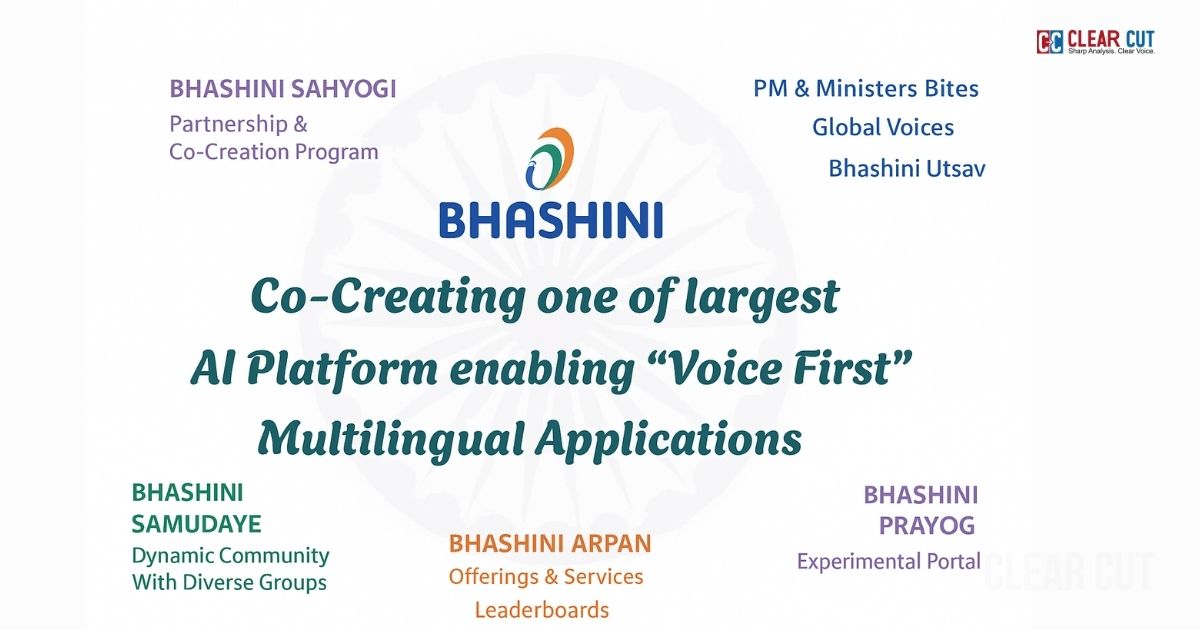Photo Credit: bhashini.gov.in
Clear Cut Research Desk
New Delhi, UPDATED: Oct 28, 2025 06:10 IST
Written By: Janmojaya Barik
India speaks in many tongues. Building a digital ecosystem for all sounds like a dream. But that is exactly what BHASHINI aims to do. Launched formally at Digital India Week in July 2022, BHASHINI, for “Bharatiya Bhasha Interface for the Net and India,” is one of the largest efforts by the state to ensure the digital revolution is inclusive, accessible, and people-centric.
Fundamentally, it aims to bridge one of India’s most enduring digital divides – language. India has over 1,600 languages and dialects, but for decades, the digital world has largely operated in English and Hindi. This exclusion is not a trivial issue; it determines who gets to access welfare schemes, online education, and digital banking. Its architects seem to understand that true digital empowerment will not come through hardware or broadband alone, but through the ability to communicate in one’s own language.
The Architecture of Inclusion
It is the design that sets it apart from previous efforts at linguistic inclusion. It is not an app or a translation utility; it is an ecosystem. It offers the underlying architecture – the APIs, the datasets, and the open-source technologies which make the translation, transcription, speech recognition, and text-to-speech capabilities available in several Indian languages. Consider India’s linguistic foundation for online services, the invisible hand that enables a website, government portal, or start-up app to communicate in Marathi, Odia, or Manipuri.
By mid-2025, according to its public reports, it supports more than 35 languages, houses about 1,600 AI models, and weaves across 18 language services. This growth has been done through partnerships with top institutes such as IITs, IIITs, and the Indian Institute of Science, as well as public engagement initiatives like “Bhasha Daan,” which encourages citizens to donate voice and text data to enhance language models. It is possibly the most people-centric way of developing AI anywhere in the world.
Technology with a Social Purpose
The significance of BHASHINI extends beyond computer translation. It is a political and cultural statement: that language no longer decides one’s digital citizenship. Consider the e-Shram portal, through which informal sector workers can register for welfare schemes. As soon as multilingual support was added, registrations from non-Hindi areas shot up. Likewise, Tripura’s recent move to implement BHASHINI tools to provide local language e-services demonstrates an increased awareness of how such technology can also close both digital and administrative gaps.
This language inclusion has real economic implications as well. Small business persons who were kept out of e-commerce platforms due to language earlier are now able to more easily use voice-based or local-language interfaces. Farmers are able to get mandi prices and weather forecasts through voice commands in their local languages. What was a top-down approach to digital governance is gradually becoming a bottom-up approach to digital participation.
The Challenge of Scale
But the tale is not easy to tell. Language technologies need huge and varied sets of data to work well. Most Indian languages, especially regional and tribal dialects, are “low resource” that is, there just isn’t enough digitized data for artificial intelligence models to learn from. Research by the Indian Institute of Science under the BHASHINI program estimated that more than 16,000 hours of speech data would need to be open-sourced and collected simply to represent the country’s larger linguistic clusters.
In addition, linguistic inclusion is both a technological and an institutional challenge. Not many state governments have even incorporated it in their e-governance ecosystem. Startups, though eager, grapple with the technical and cost aspects of integrating open APIs into their infrastructures. There is also a basic question of how will the ecosystem be supported after the first cycle of government funding?
Here, the role of the private sector will be essential. If BHASHINI is to become self-sustaining, it must transform itself into a digital public good that is inviting innovation, rather than mere compliance. The recent partnership between BHASHINI and NITI Aayog’s Atal Innovation Mission is a move in the right direction, inviting young entrepreneurs to develop vernacular digital products. The success of these partnerships will decide if it remains a policy initiative or becomes a movement.

Photo Credit: bhashini.gov.in
The Cultural Impact
Apart from economics and technology, BHASHINI poses a more profound question about digital-age cultural agency. For decades, digital India has been English-speaking India. That has determined not just who gets to participate but also whose stories fill the online space. By making it possible for millions to voice themselves in their mother tongues, it can potentially democratize knowledge production and online conversation. It can magnify local voices, maintain linguistic diversity, and counter the homogenising power of global platforms.
But there is a fine balancing act to execute. As machine translation gets better, so does the threat of cultural flattening – the denaturing of nuance, idiom, and context that make up each language. The test for it will be to ensure that technology augments linguistic diversity and not dissolves it.
The Verdict
While India’s digital revolution in the 2010s was characterized by access to devices and information, its revolution in the 2020s will be characterized by access to insight. It is a subtle yet sweeping change from digital growth to digital inclusion. It recognizes that empowerment comes not just from connection but from understanding.
By mid-2025, according to its public reports, BHASHINI supports more than 35 languages, houses about 1,600 AI models, and weaves across 18 language services. This growth has been done through partnerships with top institutes such as IITs, IIITs, and the Indian Institute of Science, as well as public engagement initiatives like “Bhasha Daan,” which encourages citizens to donate voice and text data to enhance language models. It is possibly the most people-centric way of developing AI anywhere in the world.




